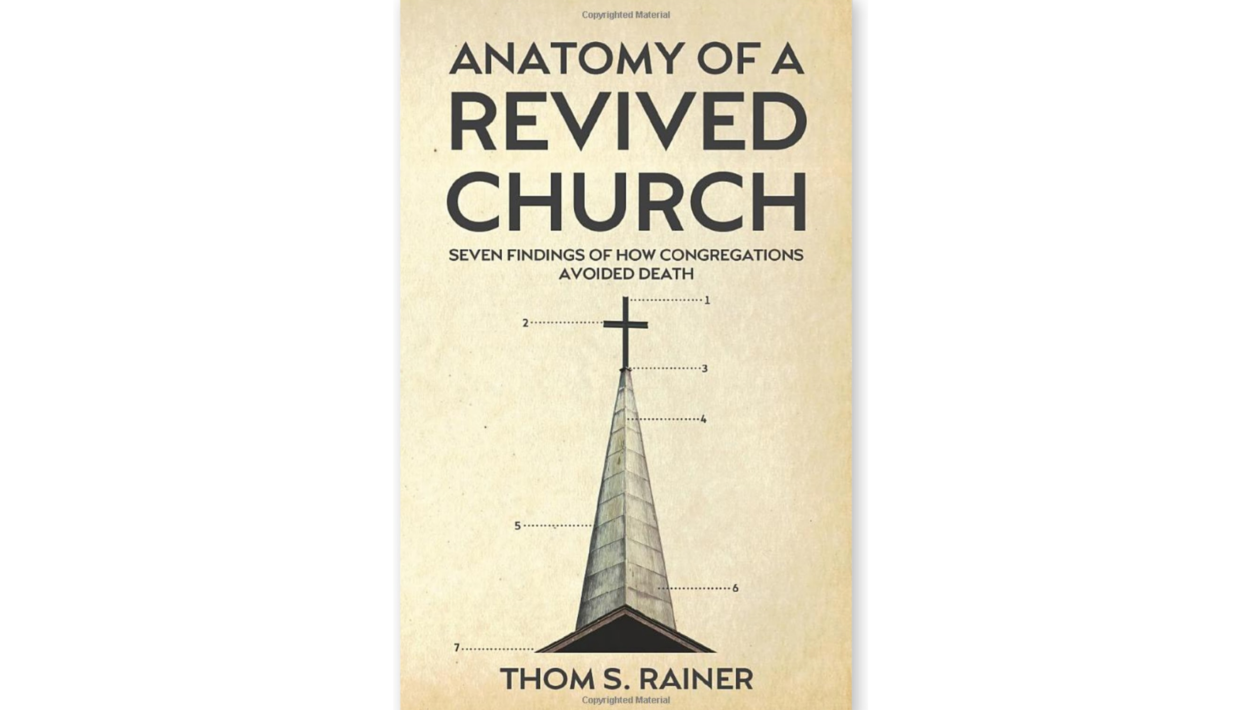By Thom S. Rainer
Spring Hill, TN: Rainer Publishing (2020)
Paperback edition, 140 pages
Reviewed by BYRON H. CORBETT
In his book, Anatomy of a Revived Church, Thom Rainer shares the valuable results of his research on hundreds of churches headed toward death but who reversed course and brought new life to their congregations. His thesis is straightforward: change or die. Rainer believes this applies to churches as much as individuals and follows his thesis statement up with a challenge: “The choice is yours” (p. 23). After issuing that challenge, the author lists seven findings that characterize dying churches that turned around and entered into a new era of revitalization and growth.
The first finding was that revitalized churches accepted responsibility for their condition. “The first component boils down to the choice of blame and denial versus acceptance and responsibility” (p. 27). Second, revitalized churches overcame the traps of traditions; “where traditions become a fixation or obsession, they often become issues of idolatry” (p. 40). Those traditions include anything from worship style and order of service to the committee’s functions and the usage of church rooms.
Third, turnaround churches expanded their scorecards. They started counting things like worship attendance, giving, and conversions to evaluate their effectiveness. Fourth, they committed to powerful prayer. Rainer writes, “I have yet to see a sustained church revitalization that was not undergirded by a powerful movement of prayer” (p. 71). The fifth finding was that turnaround churches dealt with toxins. That means they found the courage to confront toxic people who undermined leadership and drove people away from the church. Sixth, they stopped looking for the proverbial “silver bullet,” or magical, effortless solution to their problem such as a new pastor, more money, or contemporary music. The last finding of revitalized churches was they chose meaningful membership. “Membership has meaning. Membership means sacrificing for the greater good of the body. Membership has clear expectations” (p. 115).
Rainer also introduces the idea of a church accepting responsibility for its condition precedes its revival, writing, “We saw a commonality early in the turnaround, indeed before the turnaround became visible. Usually, a few leaders determined in God’s power that they would stop blaming others and other situations. They would take responsibility. . .” (p. 35). That is the most basic step toward revitalization because it creates an environment for change.
One finding that dying churches often ignore is the problem of toxic people in a congregation. It is essential to distinguish between a critic and a toxic member because while “disagreement does not equal toxicity” (p. 89), “a toxic member has a pattern of disruption, disunity, and negativity that is persistent, consistent, and intense” (p. 90). Confronting a toxic member is difficult, but ignoring him or her only makes things worse; ultimately, the church may even die unless it such members are dealt with. When a leader confronts a toxic member, they should “seek both the wisdom and the alliance of other members in the church” (p. 95).
Overcoming the idea of the “silver bullet” is also key. It means a congregation stops looking for an easy solution that will not require much work on their part and instead becomes willing to put forth whatever hard work and effort are necessary to turn their dying church around.
An underlying theme that ran through most, if not all seven, findings of revitalized churches is best summarized in the words of one of the people the author interviewed: “When our church started focusing on others instead of ourselves, the turnaround had already begun” (p. 129). That is a key idea that readers should not miss.
Although the book does an excellent job of dealing with the “what” of revitalization in the seven findings, it does not do as good a job of dealing with the “how.” The practical value would increase significantly if each result included specific examples of how churches actually implemented them.
This book would be a good discussion-starter for church leaders to address the condition of their own churches. A church’s board of elders could read the book and evaluate where their church is in terms of each of the seven findings. They could analyze each committee, program, or ministry for its effectiveness and decide whether it is still needed or should be replaced. The leadership team could develop ways to measure attendance, giving, and ministry involvement to help them identify trends sooner and test the effectiveness of the changes they were making. Another way to apply the ideas of this book would be for a church to require everyone who becomes a member through baptism, profession of faith, or transfer to participate in a membership class that incorporates information, expectations, and assimilation into ministry into its content so that the culture of the church would change.
Anatomy of a Revived Church is a necessary read for any leader or member who cares about their church, its health, and its mission. The seven findings are an excellent road map for church revitalization. The author draws on his wealth of church consulting experiences to illustrate them with stories to help readers recognize their own churches in what he is talking about.
We face a stern reality. First, in the United States, “Twenty churches close their doors every single day” (p. 14); second, in the last ten years, “the number of churches near death has grown from 35,000 to 66,000” (p. 14). For many of our churches to avoid that fate, we must confront the truth that “if given a choice between life and death, most church members and church leaders choose death if they have to make substantive changes in their churches” (Rainer, p. 137).
BYRON CORBETT is the senior pastor of the Richardson Seventh-day Adventist Church in Dallas, Texas, USA.

